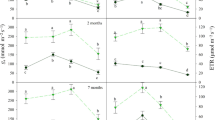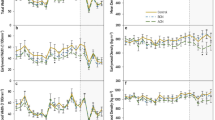Abstract
Norway spruce (Picea abies (L.) Karst.) is shade-tolerant and sensitive to high irradiance, summer frosts and winter desiccation, which can impair its reforestation success. In this study, artificial pre- and post-planting shading was examined to determine their effects on post-planting shoot and root growth as well as the vigor of one- and two-year-old Norway spruce seedlings. Three planting experiments were carried out on open nursery fields (Exp. 1, 2) and on a mounded forest clearcut in central Finland (Exp. 3). Before planting, the seedlings were stored over winter either in a freezer or on open fields under snow cover. For two weeks prior to planting, half of the seedlings were placed in the open and the other half under a horizontal shade netting (light transmittance 56 %) (Exp. 1, 2). All seedlings were planted with or without a vertical post-planting shade, which was located on the southern side. Post-planting shading enhanced shoot growth and reduced damage (better visual vigor and needle color and less pine-weevil damage) on Norway spruce seedlings for at least two years after planting (Exp. 2, 3). Those seedlings, that had been stored over winter in the open and kept in shade prior to planting seemed to benefit most from post-planting shading (Exp. 2). However, post-planting shading may give variable results, depending on the seedling quality and weather conditions after planting, and may even reduce shoot growth if no pre-planting shading is used (Exp. 1). Shoot growth may also be improved at the expense of root growth (Exp. 3). The costs of manufacturing and installing post-planting shades may limit their use in practice, for example, to selected regeneration sites where there is high risk of frost damage but where no alternative silvicultural procedure (shelterwood or nurse crop) has been used.
Similar content being viewed by others
References
Benzian B., Brown R.M. and Freeman C.R. 1974. Effect of late-season top-dressing of N (and K) applied to conifer transplants in the nursery on their survival and growth on British forest sites. Forestry 47: 153–184.
Berquist J. and Örlander G. 1998. Browsing damage by roe deer on Norway spruce seedlings planted on clearcuts of different ages: 2. Effect of seedling vigour. For. Ecol. Manage. 105: 295–302.
Cajander A.K. 1949. Forest types and their significance. Acta For. Fenn. 56 71 p.
Christersson L. and von Fricks H.A. 1988. Injuries to conifer seedlings caused by simulated summer frost and winter desiccation. Silva Fenn. 22: 195–201.
Gardner W.K., McDonald G.K., Ellis S.E., Platt M. and Flood R.G. 1991. A review of factors affecting minimum temperature on clear, windless nights. Aust. J. Agric. Res. 42: 191–203.
Geiger R. 1971. The climate near the ground. Harvard Univ. Press, Cambridge, Mass., rev. ed. 611 p.
Granberg H.B., Ottosson-Löfvenius M. and Odin H. 1993. Radiative and aerodynamic effects of an open pine shelterwood on calm, clear nights. Agric. For. Meteorol. 63: 171–188.
Groot A. and Carlson D.W. 1996. Influence of shelter on night temperatures, frost damage and bud break of white spruce seedlings. Can. J. For. Res. 26: 1531–1538.
Grossnickle S.C. 2000. Ecophysiology of northern spruce species. The performance of planted seedlings. NRC Research Press, Ottawa, 409 p.
Hosmer D.W. and Lemeshow S. 2000. Applied Logistic Regression. 2nd edn. John Wiley & Sons, New York, 392 p.
Jacobs D.F. and Steinbeck D.B. 2001. Tree shelters improve the survival and growth of planted Engelmann spruce seedlings in southwestern Colorado. West. J. Appl. For. 16: 114–120.
Khan S.R. 2000. Effects of shade on morphology, cholorophyll concentration, and cholorophyll fluorescence of four Pacific Northwest conifer species. New For. 19: 171–186.
Krasowski M.J. and Elder R.J.F. 2000. Opportunities for improvements to reforestation success. B.C. Ministry of For. Res. Program. Ext. Note 43. 13 p.
Kubin E. and Kemppainen L. 1994. Effect of soil preparation of boreal spruce forest on air and soil temperature conditions in forest regeneration areas. Acta For. Fenn. 244: 1–56.
Langvall O. and Örlander G. 2001. Effects of pine shelterwoods on microclimate and frost damage to Norway spruce seedlings. Can. J. For. Res. 31: 155–164.
Langvall O., Nilsson U. and Örlander G. 2001. Frost damage to planted Norway spruce seedlings-influence of site preparation and seedling type. For. Ecol. Manage. 141: 223-2
Leikola M. and Rikala R. 1983. The influence of the nurse crop on stand temperature conditions and the development of Norway spruce seedlings. Folia For. 559 (English summary): 1–33.
Lindkvist L. and Chen D. 1999. Air and soil frost indices in relation to plant mortality in elevated complex clear-felled terrain in Central Sweden. Clim. Res. 12: 65–75.
Lindkvist L. and Lindqvist S. 1997. Spatial and temporal variability of nocturnal summer frost in elevated complex terrain. Agric. For. Meteorol. 87: 139–159.
Lundmark T. and Hällgren J.E. 1987. Effects of frost on shaded and exposed spruce and pine seedlings planted in the field. Can. J. For. Res. 17: 1197–1201.
Malik V. and Timmer V.R. 1996. Growth, nutrient dynamics, and interspecific competition of nutrientloaded black spruce seedlings on a boreal mixedwood site. Can. J. For. Res. 26: 1651–1659.
Minore D. 1971. Shade benefits Douglas-fir in southwestern Oregon cutover area. Tree Plant. Notes 22: 22–23.
Mohammed G.H. and Parker W.C. 1999. Photosynthetic acclimation in eastern hemlock [Tsuga canadiensis (L.) Carr] seedlings following transfer of shade-grown seedlings to high light. Trees 13: 117–124.
Niinemets U. 1997. Acclimation to low irradiance in Picea abies: influence of past and present light climate on foliage structure and function. Tree Physiol. 17: 723–732.
Örlander G. 1993. Shading reduces both visible and invisible frost damage to Norway spruce seedlings in the field. Forestry 66: 27–36.
Örlander G. and Langvall O. 1993. The Asa shuttle-A system for mobile sampling of air temperature and radiation. Scand. J. For. Res. 8: 359–372.
Örlander G., Gemmel P. and Hunt J. 1990. Site preparation: A Swedish overview. FRDA Report 105 (ISSN 0835-0752). 61 p.
Örlander G., Gemmel P. and Wilhelmsson C. 1991. Effects of scarification, planting depth and planting spot on seedling establishment in a low humidity area in southern Sweden. Sveriges Lantbruksuniver-sitet, Institutionen för Skogsskötsel. Report 33. 92 p. (English summary).
Petersen G.J. 1982. The effects of artificial shade on seedling survival on Western Cascade harsh sites. Tree Plant. Notes 33: 20–23.
Repo T. 1992. Seasonal changes of frost hardiness in Picea abies and Pinus sylvestris in Finland. Can. J. For. Res. 22: 1949–1957.
Rikala R. 2000. Production and quality requirements of forest tree seedlings in Finland. Tree Plant. Notes 49: 56–60.
Ronco F. 1970. Influence of high light intensity on survival of planted Engelmann spruce. For. Sci. 16: 331–339.
Scandinavian Colour Institute, P.O. Box 49022, (Igeldammsgatan 30), S-100 28, Stockholm, Sweden, Website: http: / /www.ncscolour.com.
Strand M. and Lundmark T. 1987. Effects of low night temperature and light on chlorophyll fluoresence of field grown seedlings of Scots pine (Pinus sylvestris L.). Tree Physiol. 3: 211–224.
Viro P.J. 1959. Estimation of the effect of fertilization from needle color. Oikos 10: 183–189.
Viro P.J. 1965. Estimation of the effect of forest fertilization. Comm. Inst. For. Fenn. 59: 1–42.
Welander N.T., Gemmel P., Hellgren O. and Ottoson B. 1994. The consequences of freezing temperatures followed by high irradiance on in vivo chlorophyll fluorescence and growth in Picea abies. Physiol. Plant.91: 121–127.
Author information
Authors and Affiliations
Rights and permissions
About this article
Cite this article
Heiskanen, J. Effects of pre- and post-planting shading on growth of container Norway spruce seedlings. New Forests 27, 101–114 (2004). https://doi.org/10.1023/A:1025089425761
Issue Date:
DOI: https://doi.org/10.1023/A:1025089425761




